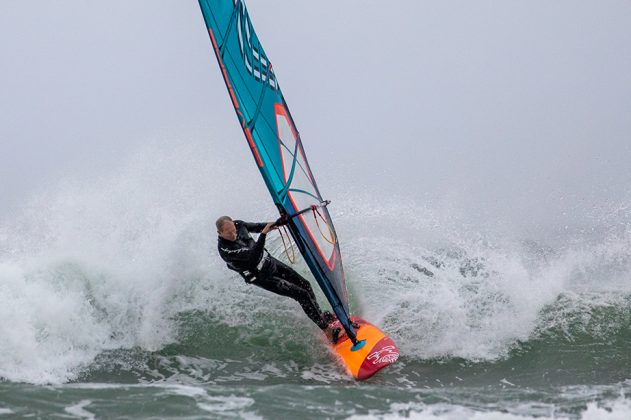PETER HART MASTERCLASS | WAVE SAILING – THE STICKING POINTS
Fresh from a season of wildly windy wave courses around Atlantic shores, Harty has much advice for all standards of wave sailor on how to overcome the classic stumbling blocks.
Words Peter Hart // Photos Hart Photography, John Michelin, Barbara Close, Simon Bassett & Simon Quinn.
Originally published within the November December ’18 edition.
Are you stuck in the waves? I don’t mean are you down in the impact zone going round and around in some eternal circular rip; but do you feel you’ve reached a point where the next level, whatever that is, is frustratingly elusive? Many people take up wave sailing as a means to launch themselves off the dreaded ‘in and out, dodgy gybe at either end’ freeride performance plateaux. The variety and ferocity of the environment forces them to up their game, move a little, get the heart rate up, lose a few pounds, trim and turn the board differently, sensitise feet and hands and experiment with smaller kit and setups. But the meteoric rise is often followed by the ‘I really should be doing better’ moments.
The good news is that so much improvement can be made without developing muscle, flexibility or lightning reflexes, but through a better understanding of the environment, cuter tactics, shrewd kit choices and then … yes perhaps, by smartening up a few essential skills. It’s an immense subject, so I’ve cherry-picked some real life examples from very recent experiences. We start by acknowledging the elephant in the room, and feeding it a big juicy bun.
FEAR
In the grand scheme of wave sailing, it was a very benign day. Had there been a pro competition, the judges would have decided that the paltry swell was too meek for a fair competition. Yet Jim stared unblinking at the horizon with a lot less colour in his ashen cheeks than a whitewashed wall. Wave sailing is a long journey. He hadn’t even got into the bus to the airport and was already homesick. Jim was a fit, planing, tacking, gybing small board sailor. He had all the skills necessary to give this a lash. What was he afraid of?
“I’d only sailed on the Essex coast, not proper waves, just big chop. I’d never seen waves roll in from an empty horizon. It was all so … different! I also had no idea where to go or what to do – and to be in honest, in front of the group I suppose I was afraid of looking a complete idiot.”
Jim was basically afraid of the unknown. The only way to overcome a fear of the unknown …is to get to know it. You don’t really teach people to wave sail. You provide an environment where they can learn from experiences – good ones and wet ones. All I did was choose the venue, the right beach with the right wind direction (just a hint of onshore), envelop him in a blanket of love and security and clarify the plan AND the exit strategy. Go out (not more than 200 m) and come back. Do that lots of times. If you get taken down, hang onto a boom or mast (not bits of webbing and above all don’t put fingers in loops). Then let the waves wash you into your depth – but don’t place yourself on the shore side of the kit. The best thing that can happen is to get mildly trashed. The reality is rarely as bad as the imagined horror. Fast forward 6 days and Jim was not only charging in and out with a beaming smile, but was also suggesting we launch further down the bay where the waves were bigger. He wasn’t on a testosterone trip. He just wanted more rides and had worked out that the bigger the waves, the easier they are to spot – and actually do stuff on.
Embrace fear – it’s a natural response that keeps us alive!
GETTING THE BIG PICTURE
Most of the common questions like, why can’t you catch more waves; why do the ones you get not do much etc., can be answered by getting an overview of the sailing spot. Here is one of my favourites. To the left you can see the wave peaking on the reef. But unless it’s very big it doesn’t actually break and flattens off into deep water, to leave you with one of those ‘where did that go?’ moments. Further inshore to the left there’s a gap between the peaks where the rip runs out. The water is choppy and waves rarely break there with any meaning. All the waves inshore are reforms, which at this state of tide are just collapsing on the banks and not offering much joy – so there’s no point coming right inshore. Further out where the sailor is taking off, the set wave is long and peeling nicely. More than that, it’s a beautiful view!
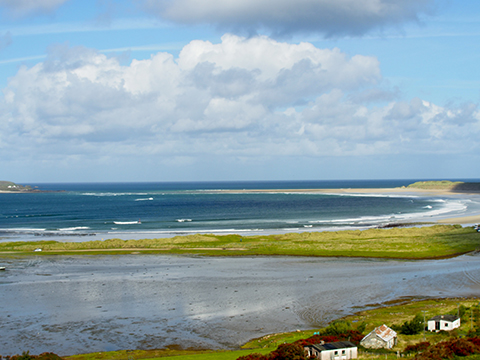
So much tactical knowledge can be learned just by looking. Photo Hart Photography.
Embrace it!
Fear is a perfectly natural response. It’s what keeps us safe. Much worse than a trembling James, is some fantasist who marches blindly forth towards the exploding shorebreak in the belief that, should something go wrong, a friendly albatross will pluck them from the waves and deliver them gently back to shore. Butterflies are fine and are the sign of someone who is alert, adrenalized but not over-confident. You just need to get them flying in formation.
Risk = reward
Fear is not the sole preserve of the first timer. It’s the number one ‘sticking’ factor all the way up the scale. Here are 2 examples from last week. In perfect Pozo-esque, side-on jumping conditions, one of the team was bleating on about the wind being from ‘the devil’ port side and that he was failing to soar. I pointed out that he was taking off too close to the wind and then extending all limbs like a sunbathing starfish before flopping tail first to the ocean. To soar you have to take off toes down, feel the wind under the board, pull the tail right up under the buttocks – thereby bearing away, which powers up the sail and boosts flight. And that is scary because it means tilting into catapult territory. No one likes catapulting, least of all when they’re 6 feet in the air.
On a dreamy side-off day, the aim of one desperado was a first aerial. An aerial is a turn at the top of the wave where the pitching lip smacks the underside of the board and launches you skywards out in front of the face. It is technically tricky and demands exquisite timing. However, the missing ingredient was ‘cohones.’ He was making lovely smooth bottom turns and then trying to chop hop off the top of a benign, sloping wave. He was missing the point … and the lip. The only way to nail an aerial is to attack the steepest, most active, most destructive part of the wave as it’s pitching. And yes – to mess it up is to become a part of that tumbling wave.
In both instances chit chat and planning will only take you so far. We can’t eliminate all risk, and ultimately you have to put your body on the line.
Only by bearing away in mid air will you feel that lift and power in a jump and learn to control it. Only by attacking the lip will you learn to tweak the timing and experience that wild redirection – and feel the consequences of arriving a second too late.
Wave sailors who turn heads are brave/foolhardy and have the scars to prove it. It’s a broken eggs and omelette situation. You can have a lot of fun in the waves on the safe side of the edge … it just depends how far you want to go.
What would you do if a divine being guaranteed you’d come to no harm? Answer. Everything.
THE BENDING WAVES
When it comes to catching waves, riding them the right way, timing top and bottom turns and holding station, it’s key to note the angle the waves are running at relative to the shore and the wind; and if they’re bending and changing direction. This picture illustrates beautifully how waves refract to mirror the shape of the bay. The wave being ridden is bending downwind. To catch it the rider will have to bear away more than he thinks; the wind will effectively be getting more and more onshore as he rides, meaning he’ll have to lengthen his bottom turn. Nearer to us, the wave is bending upwind – great for holding station. However the wind is more offshore, making it harder to catch.
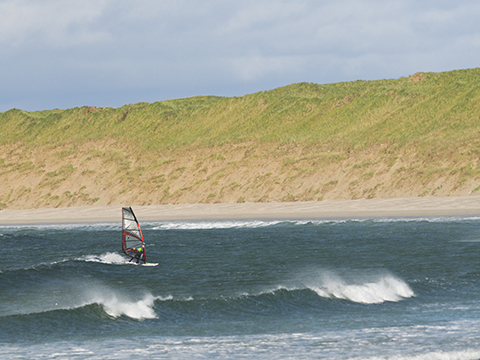
The beauty and challenge of bending waves. Photo by Hart Photography.
THE SWELL TRANSITION
The biggest tactical and technical challenge for most is moving from ‘real world’ conditions where a strong, local wind creates and drives the waves; to proper swell conditions, where wave and wind arrive care of different systems. Wave and wind coming from different directions can create a ‘rubbing tummy and tapping head with different hands’ situation. Concentrating on the wave, it’s all too easy to forget where the wind is coming from – made even trickier if the wave is bending. Clocking the direction of both wind and wave and then getting out there and feeling are the sole solutions.
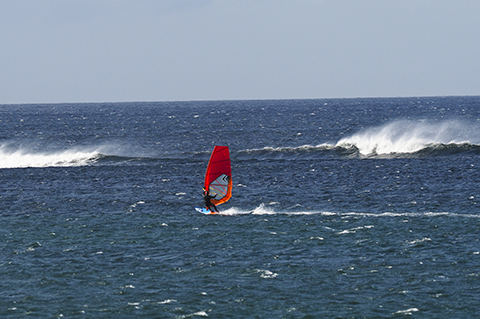
Heading out to the reef where a groundswell meets a cross offshore wind to create all to rare fantasy wave riding conditions. Photo by Hart Photography.
WAVE RIDING – MORE TIME ON THE FACE
Forget that showy-off, lip-smacking nonsense. Why many visit my doctor’s surgery is primarily because they want to catch more waves and spend more useful time on glorious smooth unbroken faces, like they do in the movies, rather than just be swept beach-wards by a barrage of foaming mush. The baffling time for many is when they make the transition from wind-blown ‘real world’ conditions, to swell. In ‘real world’ conditions you have power and therefore the speed to steer around, between and over the ill-defined wedges of water, which like ramps in a skate park, seem to be scattered randomly in your path – pop off the ones you fancy, dodge the ones you don’t.
A swell, on the other hand is longer, a more uniformed shaped wave that has rolled beyond the wind that has created it. The wind, which may not be proportionate to wave size, is often light and may be from a completely different direction.
Swell waves arrive in sets (3 is common but it can be any number). Their size, shape, direction and frequency are constantly changing due to tide, the shape of the beach, the seabed and the fact that the depression that has created them may be weakening or strengthening or moving. Anyway – this new situation provokes such statements as:
“I get smashed by them on the way out, but never seem to run into any on the way in.”
“People were getting rides, but no waves seemed to break where I was.”
“As soon as I caught one, it disappeared.”
“I always catch the ones that end up doing nothing.”
“I just couldn’t catch any, they’d just roll underneath the board … unless I caught them really late, in which case I got drilled.”
“After every wave ride, I end up way downwind.”
First of all, to love wave riding demands a change of attitude. Two days ago my Donegal pal Brendan came in and declared. “I was out there for 2 hours and caught 3 waves … it was brilliant!” It’s a quality versus quantity situation. The fisherman will forget the 12 hours sitting watching a float in the rain if he catches one whopper. On some wave days, when the peak (where the wave first breaks) is moving around and the sets are infrequent, the effort to return equation can seem very mean. But actually it only takes one wave, or sometimes just one special turn, to justify a session. If you prefer a constant level of mediocre pleasure, rather than moments of extreme ecstasy amidst long periods of struggle and frustration, then wave riding may not be for you. But still the good guys tend to get more than their fair share. The first step is observation.
FIND THE OCEANOGRAPHER IN YOU
One of the beaches we sail in Ireland is my favourite, partly because it offers an amazing range of conditions, and partly because as you approach, you can stop and observe its wide sweep from way up. The key is to interpret what you’re seeing and not just take in the scene and go “aaaah, it’s so beautiful.” If you watch when and where the waves refract, change shape and break, you can work out a lot of issues without even going on the water.
I was with a group at the lookout and the conversation went something like:
“Can you spot the sets? They’re not necessarily bigger than the other waves but they’re longer. Between the sets, there are other waves around but they’re shorter wedges which peak and then fatten out. If you catch one and bear away, you have a drop and then the wall disappears. Avoid them.
Let’s time the gap between sets – (pause). It’s 3 minutes. So if you’ve bust out over the last wave and made it to the outside, you’ve got 3 minutes to hang around before the next potential ride. If you turn around and head back in you’ll miss them. Blasters beware – wave sailing is often a ‘go slow’ waiting game!
You see the yellow foam field – that’s the impact zone where the last set broke and dredged up the sand. If you drift into that area (and are not riding a wave) you either get nailed or you’re about to waste a trip back in – so tack and gybe before it and head back out. How far out can you actually spot the sets? The swell is quite small so only about 300m out do they reveal themselves, so it’s pointless going further out than that.
Next question – are the waves breaking everywhere? There’s quite a gap upwind. Look at the water and despite the offshore wind, it’s choppy and confused. That’s the deeper water channel where the rip is going out. That’s where you were hanging around yesterday Sid – no waves to be had there.
Are the sets straight lines? No, they curve and push out in the middle to match the shape of the bay. At one end of the bay they bend upwind – at the other they bend downwind. You kept catching the waves at the far end Reg, that’s why you kept losing ground.
So how to get on them early? To catch a wave you have to be at right angles to it or the lip washes the tail away and you spin off the back. You assume if you head straight at the beach that must be the right take-off angle. But these waves only bend parallel to the beach at the last few hundred yards when they run into shallow water. Further out they’re running at a completely different angle, almost parallel to the beach. So you have to really take note of the direction of the slope and often bear away or head up.”
Do you make any kind of plan or do you just head out there and hope you run into a wave or one catches you up. If it’s the latter, don’t expect a massive return.
STUCK FOR VERY BASIC SKILLS
Last week one of my group said he really liked what I did on my last wave.
“Oh thanks – what … the rather snappy top turn with one hand hanging casually to my side?”
“Er no … that was a bit naff. You tacked off a wave that wasn’t doing much and then immediately tacked onto the next one. That was quite good.”
Damned with faint praise and all that – but compliments are few and far between these days so I’ll take what I can get. But my ‘fan’ had a very good point. Being able to tack and gybe spontaneously, off and on the plane, remains the most effective way of improving your wave count, especially on days when the break is changing and hard to line up on. And knowing you can spin round instantly and head for home if the horizon starts heaving does wonders for your general confidence. The tack is surprisingly frustrating. There is a gulf between being able to tack – and being able to tack a sub 90 litre board absolutely whenever you want, like semi-submerged, in a light shifting wind in front of a big peaking wave.
The only way is to drill it on flat water on that same board. There’s no space for a full explanation of tacking, but here are a handful of tips:
– Taking your time doesn’t help. The smaller the board and the lighter the wind, the quicker and more explosive you have to be.
– If you haven’t tacked within a second of steering towards the wind, it’s already too late.
– Hold your form and move the rig out of the way before moving the feet.
– Keep the rig at arm’s length all the time. If you feel the mast against your chest, that was the second before you hit the water.
STORM RIDING – IT’S ALL IN THE SETUP.
Storm Ali battered Atlantic shores last month. The warnings of structural damage was a signal for hardy windy types to give it as lash. Thanks to extraordinary modern kit, amateurs can sail around in 50 knots – but what frustrates many is that they can’t do much, while the pros are ripping around as if it was a fresh 20 knots. The difference is practice. For many their small sail is a bit old and brought out once a year for special occasions. It’s often on the wrong mast and badly tuned because – well … it’s hard to justify the expense. However if you want to excel in 40 knots plus, you have to tune your kit with the same precision as a slalom sailor – matching rig to board to fin, getting the rig to exhaust and provide the right balance of power and control. It’s also a fine art to sail a 3.3 well. They have a narrow power band and are easy to over-sheet. If you’re a ‘squat down and go’ type sailor you’ll be forever killing the power. The key lies in micro adjustment, relaxing and being calm in the face of the spray.
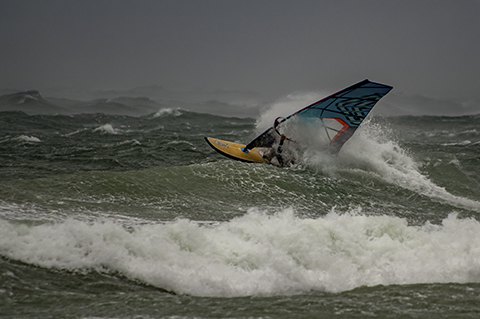
Two contrasting images of storm riding. A 4.2 in 50 knots leaves you with no option but to hunker down and take a beating. Through the goodness of my heart I had lent out my 3.7. I tried putting on extra down and outhaul, but it made it worse. Photo by John Michelin.
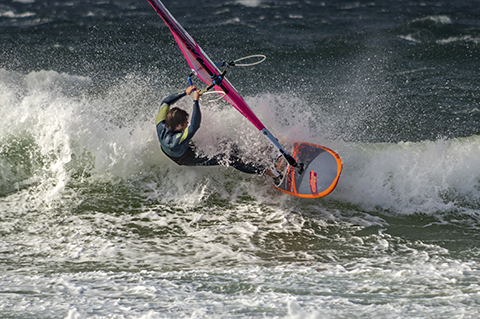
Ben Page, who has spent much time out in windy Pistol River, ripping using a 3.3 and having the same control as if it were a bog and ride day. It’s all about having the right tools for the job, tuning the hell out of them and then sailing storms more than once a year! Photo by John Michelin.
STRONG WIND WAVE SAILING
Storm Ali swept across the UK and Ireland last month and battered my wave class with gusts up to 55 knots. Some sensibly resisted the challenge for fear of crocking themselves. Others saw it like Everest. It was there and had to
be confronted. The first point is that professional ‘storm chasers’ look totally comfortable out there because they’ve obeyed the most fundamental windsurfing
algorithm, which is, they have the right kit for the job and have tuned it for the conditions. Which means they’re NOT fighting the power, which means they can relax into a normal stance balanced between the feet, ready to drop into manoeuvres. The majority fall down at the first hurdle. The right tools for the job were a 75 litre board and a 3.3 rigged on its own 340 mast. Counter intuitively that titchy sail should be rigged with plenty of shape for maximum power. Small sails are twitchy at the best of times. If you over tension out and downhauls, you make them even more so. Those whose sails were too big for the conditions tried to make them useable by over-tensioning out and downhauls – which actually made them worse. The wind bounces off the flat profile, leaves you with a tiny workable sheeting angle, and makes the sail at the same time gutless, heavy and unstable.
The twenty who were out could be divided into two neat camps – those who were exploiting the power to do stuff and those who were just sailing in and out looking to dump it. Too big a board with too big a fin or too big a sail, or, more commonly, sail set on too stiff a mast, left them hunkered down, sheeted out, squeezing upwind, tail walking, unable to do anything apart from drift in and out. If you can’t close the sail, all manoeuvres are off limits.
The well rigged meanwhile, were in the happy place of actually looking for power in 45 knot gusts, in the same way you do on a bog and ride day using a floaty wave board and a 5.3. Slightly underpowered, or at least comfortable, your instinct is to move onto the front foot which is crucial to holding the nose down and the rail in during stormy wave rides. However, being well equipped and tuned did not solve all problems. There were pilot issues – most of them a result of instinctive defensiveness. As people got into the session and became receptive to advice, these are the tips and strategies that helped.
Friendly speed
Big low pressure winds puff and blow and flick all over the place. The only way to soften the irregularities is to let the board go and build up a little apparent wind. Stationary you’re a sitting duck.
Stand up and bear away
The instinct is to squat in order to make yourself a harder object to knock over. Of course you lower your body weight to resist the initial surge, but then bear away (a little) and as the front hand loads up, stand up and let the board release. It’s only possible if you’ve got long lines that allow you to hold the rig forward and upright. If you stay squatted on your heels, you stop the board planing and will feel an unholy force through arms and body. The sea was full of people hanging under the boom monkey style, sailing too close to the wind (for fear of picking up too much speed) and going sideways. The water state at surface level is so aerated by storm winds that small fins struggle to find grip if you overload them.
Sail Normally!
For those who persisted, the advice on every run was to try and obey the windsurfing basics. Relax the grip, load up the harness, keep the rig still and direct a constant flow of pressure through the feet into the board.
STUCK DRAWING BORING LINES
“I wouldn’t say last Wednesday was the best Masterclass day ever, but it was in the top one.” As footballer manager Brian Clough might have said. Slightly side off 15-25 knot winds, clean 4-6 foot waves that just went on and on. It was on the right side of the exciting/darn-right-dangerous frontier. All the team fronted up, made it out (not a given in gusty side off winds) and had the rides of their lives. As is often the case when there’s a peachy forecast for this corner of Ireland, a few pros rolled up at dawn including Timo Mullen and many times Irish champion Oisin van Gelderen. What made for fascinating video footage for my group viewing was watching the good guys sail the same waves as my students – and noting the differences.
FUNCTION THEN FUN
We are bombarded by money shots – sailors in impossibly vertical positions in the most extreme pockets of the biggest waves. But what those shots fail to show is how they got to that position, which was teasing tiny kit out through the bombs in a flaky wind and then being able to manoeuvre into the exact right spot for take off. Tacking a tiny board off the plane is the real skill – the wave riding bit is easy.
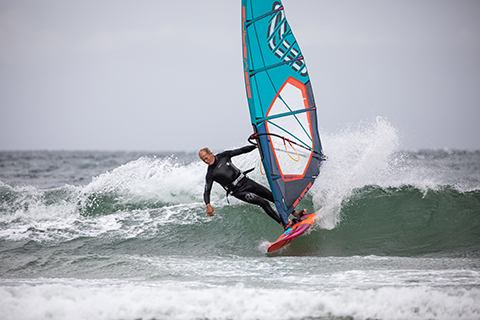
One of Harty’s clients was not that impressed by his one handed top turn….
Photo Barbara Close.
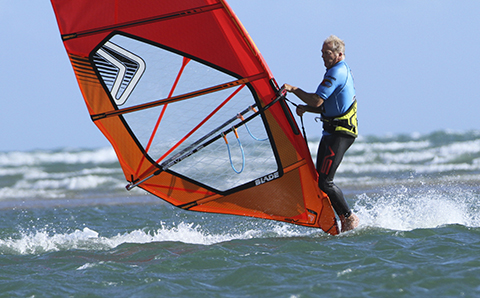
….but he was impressed by how he tacked. Photo Simon Basset.
Little kit
The choice of sail size for our bigger guys (80 kg plus) was around 5.3. The pros were on a square metre smaller. In side off winds, the rule is that if you can plane out easily, you’re going to be stacked on the wave face. The wave is taking you into wind and the wind accelerates up the slope. Being overpowered when riding is the most limiting factor. You can’t hide the sail, forcing you into long, shallow bottom turns. And as you open out the sail coming off the lip, the power pulls you over the board and stops you engaging your heel edge and throwing that crazy plume of spray.
The flaw in the cunning plan of going smaller is that you can’t ride a wave unless you can get out. And a little extra grunt is very useful in holding you upright in the lulls and helping you bust through whitewater. The hidden skill of the pros is teasing tiny kit out through the break. They don’t just stand there – they’re working it all the time to stay afloat and make precious yards – only achievable with fitness, skill, practice and many drillings.
THE FREEWAVE VS WAVE QUESTION
The supremely versatile freewave board is the popular choice for many who join me on wave courses – because in reality it’s going to spend a lot more time on the flat than on the wave face. When that decision is challenged is when they try to explore the really exciting sections of the wave and experience the freewave ‘kick.’ Rather than bottoming out smoothly from a steep drop or carving sweetly on the curviest section, the straight rocker catches. After which they’re persuaded to spend more time on the less expensive shoulder. An assured way to leap to the next riding level is to invest in a wave board.
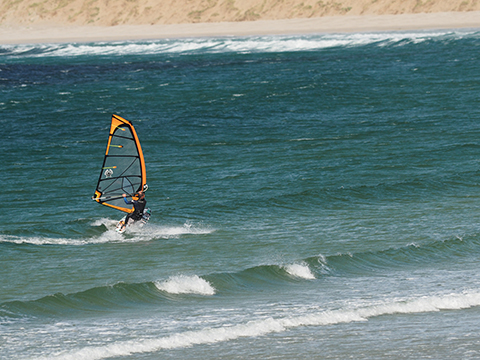
A ‘freewave’ is the perfect tool for the job of getting into waves. On this small wave it generates heaps of speed. It also planes early, isn’t too technical to ride and fills you with confidence. But as the wave size creeps over head and you crave faster, tighter, steeper turns, it’s time to invest in a wave board. Photo Hart Photography.
The ‘Freewave’ factor
The board of choice for many of the group was a freewave – because it’s a board they get more use out of on the choppy waters of home. Freewaves work really well for first timers. They pop on the plane a bit earlier, are less technical to sail and when fitted with thrusters, carve a mean arc. It’s just in the last 10% when you’re looking to explore the naughty areas of the wave, that you can experience what I call the ‘freewave kick.’ As you drop down a really steep face or try to carve a tight turn half way up the face, the straight rocker catches and you get a kick which stops the flow … or worse. After a couple of rinses you naturally play it safer. The tool to explore the curviest sections and reach for the next level, is a wave board. The pros had a few to choose from.
Speeding it up
The biggest difference between pro and am was the speed of everything. The time between initiating bottom and top turns for the good guys was less than 2 seconds. For most it’s often twice that. For some the routine is half a carve gybe, wait for wave to catch up, float down face, repeat process. The good guys gouge and release the edge immediately and let the buoyancy of the rail boost them into their top turn. The start of one turn is the trigger for the next – in the same way as a skier or snowboarder rebounds from one edge to the next.
Separation
How much you can separate upper from lower body determines how quickly you can change direction. Those lacking a little confidence tend to follow the board, hips and upper body in a line, never straying too far from the centreline. Those with an eye to carve tight lines are way ahead of the board. As they bottom turn, their hips project way beyond the inside edge towards the wave – but then before the board has climbed the face, their upper body and head have already turned to face down the slope. We’re back to the fear thing again. There has to be a willingness to throw yourself into empty spaces. Oh yes – and there is one other major tip – find yourself a job that allows you to down tools at the hint of a good forecast!
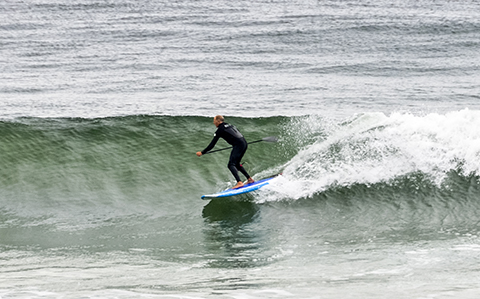
As a final message, I was out for 2 hours paddling around before I caught this wave. To get out of wave sailing ruts, set yourself up for quality rather than quantity. The really good days are often a lot of work for a couple of good turns – but you’ll remember them forever. Photo Simon Quinn.
Harty returns next month with more research and lessons from the frontline as the windy season starts. Check out his website – www.peter-hart.com for more info. about his 2019 clinics.


